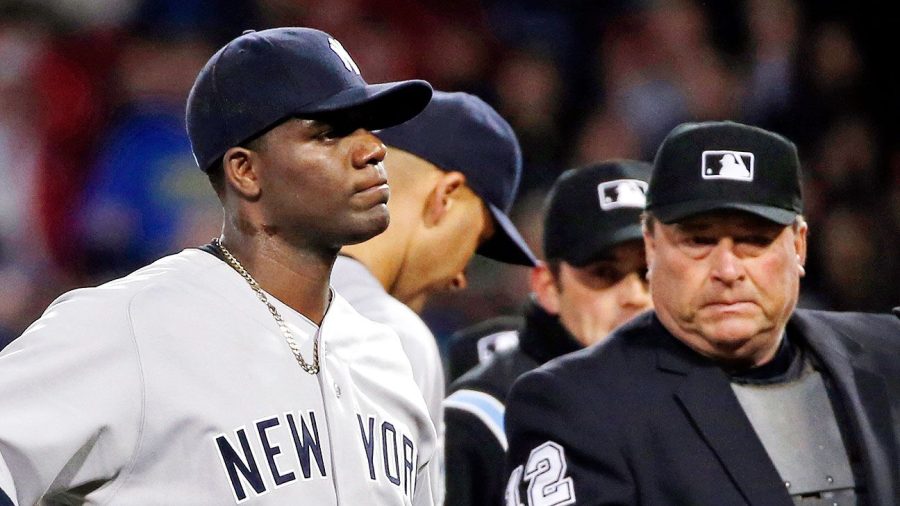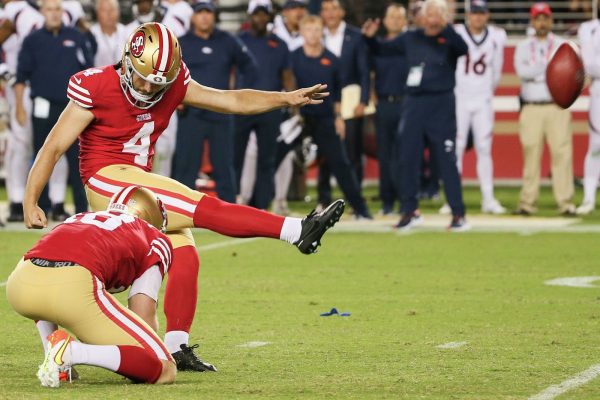Legalizing grip-enhancing substances for MLB pitchers: a step towards batter safety
Yankees pitcher Michael Pineda ejected from the game after umpires discover pine tar on his neck. Statistics suggest a correlation between substance use and batter safety.
A twenty-pound bowling ball falling on your head from under a ten-foot basketball hoop produces the same kinetic energy as a 90 mph fastball hitting your head. The amount of batters getting hit by pitches has been noticeably increasing. According to StatCast, MLB’s (Major League Baseball) official database containing information on every pitch thrown each season, there are roughly 400 more hit-by-pitches in the 2022 season compared to 2017, and 700 more hit-by-pitches compared to 2012. Likewise, MLB has also initiated a wave of new crackdowns on grip-enhancing foreign substances in the last four seasons and should adopt a policy allowing the use of a single standardized substance, similar to the method used by the NPB (Nippon Professional Baseball), Japan’s professional baseball league.
Baseballs in the MLB have been criticized for being far too slippery, causing pitchers to have to resort to doctoring baseballs. In Japan, all baseballs are already coated in a sticky substance out of the wrapper. The concept of a single allowed substance is something the MLB needs—desperately.
Doctoring baseballs already existed as early as 1871, where pitchers would spit on the ball to reduce friction upon release. This pitch, known as the spitball, became illegal in 1920 when Ray Chapman was hit in the head and killed by this pitch. Over a century later, doctoring baseballs has become even more creative. Sunscreen, rosin, pine tar, and vaseline are just a few of the substances pitchers use today. In fact, according to Sports Illustrated, 80-90% of pitchers in the MLB use foreign substances. But on top of using substances, they heavily rely on substances for grip, and banning them is a lot more complicated than it sounds. Mateo Miramontes, a former pitcher for the New York Mets organization, claims that substances were necessary for pitchers to perform well.
“In baseball it’s a lot of force but it’s speed,” Miramontes said. “You want arm speed, [and] you want wrist snap to throw the ball hard, and so if you don’t have to grip [the ball] really hard, then you can relax and throw harder. The minute you have to worry about grip, you slow down because you don’t want to hit anyone in the head nor hit it off the backstop.”
In the past decade, speed has become the main emphasis for pitchers, hence the importance of substances. According to StatCast, the league-average fastball speed has increased from 91.9 mph to 93.7 mph from 2008 to 2022. This is likely due to the introduction of sabermetrics, which is the practice of using statistics to analyze the game.
“With all the data they collect now, [they know] if a fastball is over [a specific] mph, the chances of a hit are way down,” Miramontes said. “The old school way to think about that was that you could still get outs without velocity by hitting spots in the strike zone.”
Now the emphasis on control to hit specific spots is paired with an emphasis on pure velocity. StatCast has found that 55% of pitches have been thrown high in the strike zone in 2022 as opposed to 40% in 2018. Particularly, MLB has noticed an increase in high and inside pitches, which are around the upper-inside corner of the strike zone. Why? Because of the adjustments within the game.
Historically, pitchers would throw sinkers and sliders to create ground balls, because it would then require three base-hits for the offense to score. However, the strategy has since adjusted, because hitters are now trying to hit home runs because of how difficult it is to get three base-hits in a single inning. And because sinkers and sliders that angle downwards actually help batters hit balls in the air, high fastballs have become the new norm.
“Everybody now is trying to hit fly balls,” Miramontes said. “When you try to hit the ball in the air, you have more of a loop of a swing, which means there’s a huge area you can’t get the barrel [of the bat] to, which is up-and-in. They have calculated what pitch at what velocity gets the least amount of hits, and it’s a fastball up-and-in.”
A fastball up and in is very close to the batter’s head, and in order to consistently hit the zone accurately, pitchers need to have solid grip on the ball. Without adequate control, hitting batters in the head becomes more common. Therefore, sticky substances could possibly help prevent batters from getting hit so often.
“Two seasons ago when they really cracked down on sticky stuff, guys were getting hit right away,” Miramontes said. “There were more guys hit around the neck area in the first three weeks than there had been in the last couple of seasons. Without that grip, that up-and-in pitch is flying in a bit more.”
Getting hit in the face by a pitch can cause both physical injury and mental trauma. Former MVP Giancarlo Stanton had his jaw broken by a fastball to the face. Fellow former MVP Bryce Harper experienced a batting slump after getting hit in the face, according to StatCast, having the worst batting month of his career striking out 40% of the time. In an interview with ESPN, MLB catcher Mike McFarlane said that “When the ball is coming at your head at 95 mph, that is the fear of God. That sound you hear is the thumping of your heart.” Brennan Boesch, another MLB player, told ESPN that it was simply a “helpless feeling” and that “you just pray that it doesn’t hit you in the face.” Some of the trauma can have career-long effects, according to Miramontes.
“If you get hit in the back or the butt, whatever, but if you get hit in the head or the face, that definitely changes,” Miramontes said. “You go up there and as a hitter, your mental space is ‘I don’t want to get hit.’ I’ve seen some guys get hit in the head and they just can’t hit anymore. Every time the pitcher throws a ball they just step away. And they don’t mean to, but it’s just their natural reaction not to get hit.”
But making substances legal would be extremely difficult because of a new substance called spider tack, which is essentially like superglue. Spider tack is on an entirely different level compared to the existing substances. Ari Alexander, an Emmy-winning sports anchor and former collegiate baseball player, tested rosin, pine tar, both popular substances, and then spider tack on his pitches. He found that rosin and pine tar made no noticeable difference in terms of spin rate, as higher spin rate equals more movement which means the ball is harder to hit. However, spider tack caused the spin rate to significantly spike.
MLB doesn’t seem to really care either, despite knowing about spider tack usage. In a series of tweets, former MLB star pitcher Trevor Bauer openly used the substance after claiming that rival pitcher Gerrit Cole used it and faced no repercussions. Bauer then won a Cy Young award that season. This isn’t the first time MLB ignores glaring issues. Gaylord Perry, who used the spitball even when it was illegal, wrote an entire book titled Me and the Spitball in the prime of his career admitting that he used it and even explained how he used it. He then used the pitch for nine more years and then was inducted into the Baseball Hall of Fame.
This is where MLB should draw the line and use some substances to help protect batters while not allowing other substances like spider tack which makes pitchers way too strong. MLB should allow one substance that does not improve performance, but rather just grip to still allow pitchers to have control. Standard concoctions like rosin and sunscreen are extremely important for pitchers to maintain control and also statistically don’t give them much of a competitive advantage with spin rate. But banning spider tack is necessary, because baseball games are already criticized for being snooze-fests because of how little action there is, and making pitchers stronger would only make it worse because there would be even less hits.
Obviously, policing implicit player behaviors is a difficult task, especially when spider tack is only one of hundreds of ways to cheat in baseball. But by allowing pitchers to at least use one substance, we are ensuring that batters will be hit less often on accident.

Edi Zhang is a senior and will spend his fourth year on The Stampede as the Editor-in-Chief. He is honored...






